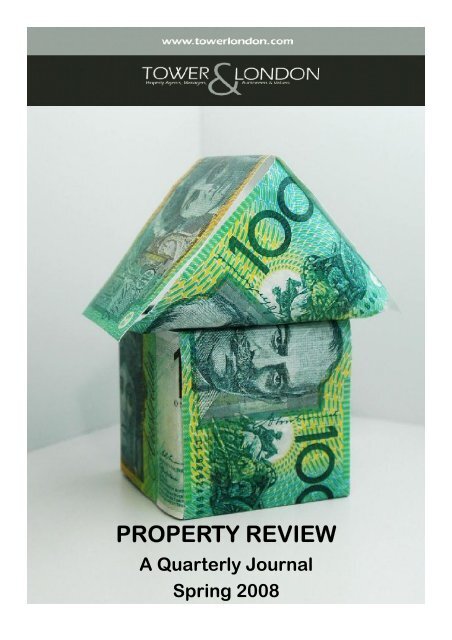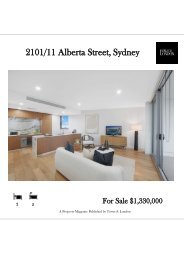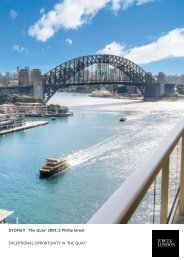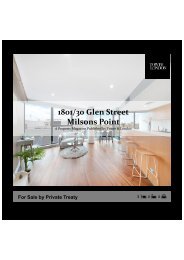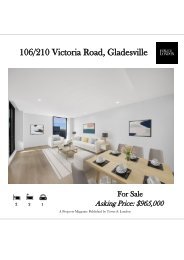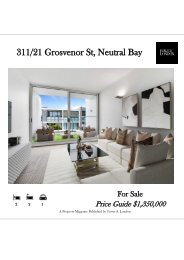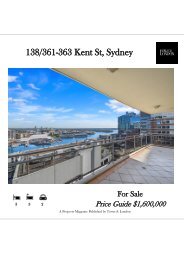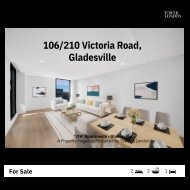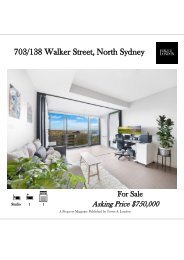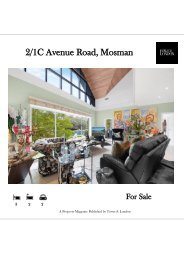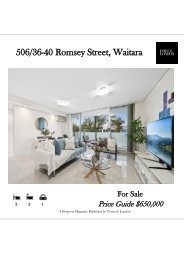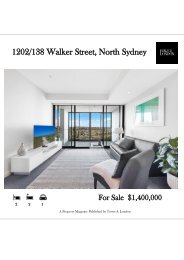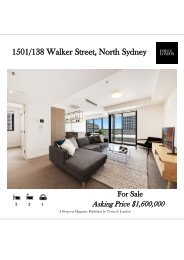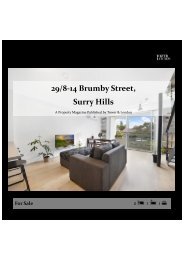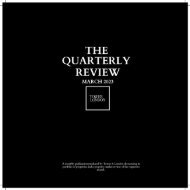2008 Spring
You also want an ePaper? Increase the reach of your titles
YUMPU automatically turns print PDFs into web optimized ePapers that Google loves.
PROPERTY REVIEW<br />
A Quarterly Journal<br />
<strong>Spring</strong> <strong>2008</strong>
PROPERTY REVIEW<br />
A quarterly journal published by<br />
Tower & London<br />
Managing Director: John Tower<br />
Editor: Matilda Haddad<br />
Design and Layout: Matilda Haddad<br />
Published with thanks to Katherine Lim, Laura Scott & Luke Pickard<br />
Enquiries regarding this journal should be made to:<br />
Tower & London<br />
38 Alfred Street,<br />
Milsons Point NSW 2061<br />
Phone: (61) 2 9956 6500 Fax (61) 2 9956 6522<br />
Email: reception@towerlondon.com<br />
Disclaimer:<br />
The information contained in this publication is for general information purposes only.<br />
Readers are advised that while an earnest effort has been taken to ensure the information in this<br />
document was obtained from reliable sources, Tower & London gives no guarantees or warranties,<br />
written or implied, over the accuracy of the information provided. Tower & London Pty Limited disclaims<br />
all responsibility for any loss or damage suffered as a result of the use of the contents of this publication.<br />
The views expressed in this publication are those of the writers and do not necessarily reflect the views of<br />
the publisher.
C o n t e n t s<br />
Rent hikes explained<br />
John Tower 2<br />
Generation Rent<br />
Matilda Haddad 7<br />
Property Prices Review:<br />
- Australian Capital Cities 10<br />
- Lower North Shore, Sydney 11<br />
- Rental movements 11<br />
Past Rentals 12<br />
Current Rentals 13<br />
Current Sales 14 & 15<br />
Tower and London<br />
Our Team 16<br />
Our Offices 17<br />
Page 1
The Emperors New Clothes<br />
John Tower,<br />
Property Valuer<br />
The notion that<br />
recent rent hikes<br />
are a direct result<br />
of rising interest<br />
rates is problematic as there are many<br />
other factors being ignored. Interest rates<br />
have been increasing for years and yet<br />
renters are only now being asked to pay<br />
up.<br />
Below is a deep look at these factors, with<br />
a view towards understanding how they, in<br />
conjunction with interest rates, affect the<br />
current rental market.<br />
The Australian economy<br />
has proven to be robust; riding on the back a<br />
mineral resources boom, substantially fuelled<br />
by China’s industrialisation and economic<br />
growth. While areas of the economy like<br />
manufacturing and tourism under perform, the<br />
export of mineral resources is booming.<br />
This is having profound effects on the<br />
economy in areas of job growth and revenue<br />
from company taxes, which on the surface,<br />
appears to have led to budget surpluses, an<br />
increase in government grants to families and<br />
a lowering of individual taxes.<br />
The material below is the first and last<br />
paragraph found in the RBA’s Statement on<br />
Monetary Policy that was issued last May:<br />
“Inflation in Australia picked up<br />
over the past year in an<br />
environment of limited spare<br />
capacity and earlier strong<br />
demand. In these circumstances, a<br />
significant slowing in the growth of<br />
demand from the rapid pace of<br />
2007 will be needed in order to<br />
return inflation to the target over<br />
time. There are signs that such<br />
moderation is now occurring.”<br />
“At it’s most recent meeting, the<br />
Board considered whether the<br />
current stance of monetary policy<br />
was sufficiently restrictive to<br />
reduce inflation over time. On<br />
balance, the Board judged that the<br />
setting of monetary policy was<br />
appropriate for the time being. The<br />
Board will continue to monitor<br />
developments, and will make<br />
adjustments to policy as needed to<br />
ensure that inflation returns over<br />
time to the medium-term target.”<br />
A deeper look reveals the wealth and<br />
growth is concentrated to the minerals rich<br />
states such as Queensland and Western<br />
Australia; whereas other states are faring<br />
poorly in comparison.<br />
Nevertheless, successive tax cuts and the<br />
relatively low unemployment rate in recent<br />
years has pushed the consumer price inflation<br />
higher than what the Reserve Bank of<br />
Australia (RBA) would like. The only lever the<br />
Reserve Bank of Australia has is Monitory<br />
Policy, being the cash rate and the base<br />
interest rate and this must be used effectively.<br />
Page 2
A mortgage is often the biggest financial<br />
responsibility faced by individuals and families<br />
in Australia. Therefore, the rate of interest<br />
rate applied to mortgages is a major concern.<br />
According to RBA’s report on Domestic<br />
Economic Conditions, non performing loans<br />
account for around 0.4 per cent of the value<br />
of housing loans on bank’s domestic books<br />
for March.<br />
The RBA sets the level paid by banks on<br />
the wholesale market, then banks charge<br />
homeowners a premium on the cost of<br />
borrowing, which in turn yields a profit for the<br />
bank and its shareholders.<br />
Interest rates set by RBA have climbed<br />
steadily over the last few years. The major<br />
banks also increased their rates, independent<br />
of RBA’s hikes, to make up for their losses<br />
overseas, particularly after the US-led credit<br />
crunch and the cost of the supply of funds.<br />
The shortage in the supply of funds has<br />
led to two important consequences: banks<br />
have passed on their costs to borrowers,<br />
claiming high borrowing costs are affecting<br />
their profit margins and then, as a result of the<br />
crunch, smaller lenders with limited access to<br />
funds, are unable to compete for customers<br />
and are quashed out of the market.<br />
At its most basic level, this means<br />
mortgage repayments have risen to levels<br />
that directly affect property owners, especially<br />
as most Australians are already dealing with<br />
other rising costs for petrol and food.<br />
The Australian<br />
Bureau of Statistics<br />
(ABS) figures for<br />
May <strong>2008</strong> show that,<br />
in trend terms, the<br />
total value of dwelling<br />
finance commitments, excluding alterations<br />
and additions, decreased by 3.6 per cent from<br />
April and owner occupied housing and<br />
investment housing commitments decreased<br />
by 3.7 per cent and 3.4 per cent respectively.<br />
This is a very steep decline from figures<br />
recorded in late 2007.<br />
Page 3
Developments in financing<br />
activity and in the established<br />
housing market generally point<br />
to a more subdued demand<br />
this year.<br />
Young Australians, who by<br />
previous generations<br />
standards, would normally be<br />
opting for home ownership at<br />
this stage in their lives, are<br />
turning to renting instead.<br />
This demographic, along with older owner<br />
occupiers, are being deterred by the current<br />
high interest rates, stamp duties and the lack<br />
of any signs of capital gains to be accrued<br />
from participating in the housing market,<br />
despite the current trend for rising rents.<br />
HIA Chief Economist, Harley Dale,<br />
believes the Junes figures, which register a<br />
seventh consecutive trend decline for building<br />
approvals, signal a weakening in residential<br />
construction over the second half of <strong>2008</strong> and<br />
an inability of the housing industry to keep up<br />
with demand.<br />
“The responsiveness of supply to<br />
growing demand has been crippled<br />
by draconian regulation, ridiculous tax<br />
grabs, restrictive land release<br />
programs, and a failure to deliver<br />
required industry skill packages,”<br />
added Mr Dale.<br />
A look at building approvals from late 2007<br />
to the present shows a repetitive pattern of<br />
decline. Most pronounced are the low figures<br />
recorded for units. This is perhaps a reflection<br />
of the waning confidence developers have<br />
over the return of investors to the market,<br />
particularly those who buy big chunks off the<br />
plan.<br />
According to the Housing<br />
Industry Association (HIA),<br />
building approvals weakened<br />
last June, following a big drop<br />
in May. These figures have<br />
reached their lowest level<br />
since the end of 2006.<br />
On a seasonally adjusted basis, total<br />
building approvals fell by 0.7 per cent in June,<br />
following a drop of 7.8 per cent in May. The<br />
number of detached house approvals was<br />
down by 0.8 per cent and approvals for the<br />
more volatile multi-unit segment eased by 0.5<br />
per cent following a 20 per cent drop the<br />
previous month.<br />
Over the six months leading up to June<br />
<strong>2008</strong>, detached house approvals fell 2.4 per<br />
cent and multi-unit sector the decline was a<br />
sharper 13.3 per cent.<br />
Photograph courtesy of constructionphotographs.com<br />
On a state by state basis, the number of<br />
seasonally adjusted building approvals in<br />
June fell by 34.5 per cent in Tasmania; 16.5<br />
per cent in New South Wales, 7.6 per cent in<br />
South Australia and 6.5 per cent in Western<br />
Australia. Similarly, the trend number of<br />
building approvals fell by 6.4 per cent in the<br />
Northern Territory and 1.5 per cent in<br />
Queensland. Only Victoria and the Australian<br />
Capital Territory saw some improvements,<br />
with recorded figures up by 9.9 per cent and<br />
17.4 per cent respectively.<br />
Page 4
The preliminary estimated resident<br />
population (ERP) of Australia at 31 December<br />
2007 was 21,181,000 persons. This is an<br />
increase of 331,900 from the figure estimated<br />
at the same time the previous year.<br />
The increase is the largest<br />
recorded for a 12 month period since<br />
the ERP concept was introduced in<br />
1971.<br />
According to the demographic<br />
statistics provided by ABS, this puts<br />
the rate at 1.59 per cent, making it the<br />
fastest annual growth rate recorded<br />
since 1.78 per cent in 1988.<br />
The growth of Australia's population has<br />
two components: natural increase (number of<br />
births minus number of deaths) and net<br />
overseas migration (number of arrivals minus<br />
number of permanent departures).<br />
Natural Increase: at the end of 2007, this<br />
was estimated to be around 147,400 persons.<br />
This figure is a whopping 15,000 higher than<br />
the 132,400, which was recorded for 2006.<br />
Net Overseas Migration (NOM): for the<br />
year ended 31 December 2007, it was<br />
estimated 410,900 persons arrived into<br />
Australia while 226,400 departed. The<br />
contribution made to the population growth by<br />
NOM (55.6%) was higher than that of natural<br />
increase (44.4%).<br />
This population increase puts a constant<br />
strain on the housing market, particularly<br />
affecting rental vacancy rates and the<br />
average cost of renting.<br />
There are 1.6 million renter households in<br />
Australia. The current shortage of well<br />
positioned and affordable housing suggests<br />
that a very large section of the population can<br />
be described experiencing some level of<br />
‘housing stress’.<br />
The Federal Government, aware of the<br />
shortage of reasonably priced properties, has<br />
launched the National Rental affordability<br />
Scheme, which promises to provide 50,000<br />
new and affordable homes for renters at 20<br />
per cent below the market rate. The<br />
Government also promises to supply a further<br />
50,000 homes if this does not<br />
appropriately ease the strains of<br />
the shortage.<br />
These recent increases<br />
suffered by renters have been big<br />
news items in the media. The<br />
rising costs of living and renting<br />
is presented through numerous<br />
‘hard luck’ stories that depict<br />
desperate families and young<br />
Australians queuing up at opens and battling<br />
a bidding war in order to find suitable housing.<br />
Australian Property Monitors recently<br />
reported that Australian capital cities had<br />
experienced double digit rent increases over<br />
the past year and judged Sydney and Perth<br />
as the least affordable places to live in<br />
Australia. The average rent for a two bedroom<br />
apartment is Sydney is now $400 per week<br />
compared with $360 per for the same period<br />
last year, similar increases are typical for<br />
three bedroom houses.<br />
The Real Estate<br />
Institute of NSW<br />
(REINSW), estimates<br />
Sydney’s July vacancy<br />
r a t e s i n p r i m e<br />
residential areas (within<br />
10 kilometres of the city), to be around 1.2.<br />
have been fluctuating between 1.5 and 0.8<br />
per cent over the past 12 months and have<br />
rested at 1.2 in the latest July figures.<br />
REINSW believes a<br />
vacancy rate of<br />
around 3 per cent is<br />
most desirable as<br />
this is when supply<br />
adequately meets<br />
demand.<br />
Page 5
The ingredients for rent rises are all there:<br />
• Investors are not buying, therefore<br />
developers are not building. Bingo!<br />
Investors are a key ingredient.<br />
Developers rely on investors more than<br />
owner occupiers. Many properties are<br />
sold as investments off the plan and a<br />
good percentage of these transactions<br />
take place even before construction<br />
finance is approved. When investment<br />
is down, properties are sold to owner<br />
occupiers and this reduces the share<br />
of accommodation available for rent.<br />
• Generation Y put a lot of pressure on<br />
the rental market: renting is not an intrinsic<br />
part of this demographic, in fact, if given the<br />
chance and affordability space, Gen Y would<br />
flock to the market, using the Internet to<br />
source important property information. But,<br />
resultant from the deficiency of adequate, well<br />
placed and affordable property, Australia’s<br />
young adults are choosing to rent homes that<br />
are near where they need or want to spend<br />
their time. This in turn directly affects vacancy<br />
rates and rent prices.<br />
• Australia’s Population increase also<br />
affects supply and demand: the number of<br />
people leaving Australian shores is not<br />
enough to level out the demand for<br />
accommodation placed on the rental market<br />
because of a growing population with limited<br />
supply.<br />
• Building approvals are down because<br />
Governments impose many restrictions<br />
and taxes on the developers: The NSW<br />
government in particular imposes heavy<br />
taxes on property developers. Real<br />
Estate Institute of New South Wales<br />
(REINSW) President Steve Martin<br />
believes pressures could be eased if tax<br />
relief and other incentives are offered.<br />
It must also be noted that governments<br />
have always imposed taxes of varying<br />
degrees, so why does it matter now and not<br />
between 2002 and 2004 when apartment<br />
buildings were mushrooming everywhere?<br />
Building approvals are slipping, but the<br />
affects of these should not be affecting<br />
current rent levels. The drop in last June’s<br />
figures will not be felt for another 18 months<br />
to two years, when the buildings are<br />
completed.<br />
The question then is: why are<br />
investors not buying, even<br />
though rents are high and<br />
o c c u p a t i o n i s v i r t u a l l y<br />
guaranteed? Rate of return on an<br />
investment apartment is currently at<br />
5.1%, much higher than when the<br />
market was running hot in 2003. It is<br />
the value of a property, together<br />
with the interest rates, that makes<br />
residential property unattractive to invertors.<br />
Unfortunately, in Australia there are<br />
investors who fuel the property market when<br />
things are looking up and then desert the<br />
market when sentient is not favourable. It is<br />
my opinion that one of two things must<br />
happen so that investors return to the market.<br />
First, interest rates must come down so<br />
that the real cost of owning an investment<br />
property becomes less of a burden. This is<br />
most likely, given the latest economic<br />
indicators. Or, alternatively, property values<br />
must come down, as the continuation of rising<br />
rents can only last as long as tenants can<br />
afford it and most tenants have almost<br />
reached this peak.<br />
More should be done to attract middle<br />
level investors to the residential property<br />
market. Small family superannuation funds<br />
should be encouraged to participate and then,<br />
when more cashed up investors<br />
begin to partake, interest rate levels<br />
will cease to be as significant.<br />
Interest rates are only one factor in<br />
the purchasing decisions made by<br />
investors. The others are property<br />
values, rental return, building<br />
expenses, capital gains and long term<br />
viability of the locality. These factors, in<br />
conjunction with the other economic and<br />
societal conditions in Australia, affect the<br />
Australian rental market.<br />
Page 6
G e n e r a t i o n<br />
Matilda Haddad,<br />
Communications Advisor<br />
A discussion on renting in<br />
Sydney is not complete<br />
without also taking a look at<br />
‘Generation Y’ and their<br />
presence in the housing<br />
market.<br />
As described by the Centre for Affordable<br />
Housing, housing is a high price commodity.<br />
Although the last census shows the median<br />
gross individual income increased by 24 per<br />
cent between 2001 and 2006, house prices<br />
have doubled in all the major capital cities,<br />
making affordable home ownership an<br />
unattainable pipe dream for many of<br />
Australia’s young people.<br />
The First Home Owner Grant has been<br />
fixed at $7,000 for over eight years and with<br />
doubling house prices, it<br />
no longer adequately<br />
provides the bolster it<br />
once did.<br />
Figures from the<br />
NSW Department of<br />
Housing and Australian Bureau of Statistics<br />
(ABS) show that first home buyers account for<br />
barely one in six (18.4 per cent) of all home<br />
purchases. As a result, the Real Estate<br />
Institute of Australia (REIA) has called on the<br />
government to make it easier for first home<br />
buyers to get into the market by doubling the<br />
grant.<br />
R e n t<br />
average annual wage,<br />
where as in 1996 only<br />
four times the average<br />
annual wage was<br />
needed. Also, home<br />
buyers now dispense<br />
around a third of their income (32.3 per cent)<br />
on mortgage repayments where as in 1996 it<br />
was 17.9 per cent.<br />
A McCrindle report highlighting the<br />
importance of young Australians participating<br />
in the economy and the housing market<br />
shows this demographic make up around 20<br />
per cent of the population (4.2 million).<br />
Generation Ys are more formally educated<br />
than their predecessors and with improved<br />
high school retention rates in years 10 and 12<br />
and record levels in university admittance,<br />
one would assume Australia’s young people<br />
would be economically better off, but many<br />
are not.<br />
Further education delays entry to the work<br />
force and increases the competition in labour<br />
markets amongst graduates. As a result,<br />
many young people are finding themselves<br />
either underemployed or struggling to find<br />
stable, long-term employment.<br />
With reports showing that 40 per cent of Gen<br />
Y are employed on a casual basis and<br />
McCrindle research uncovering that 57 per<br />
cent of Gen Ys still rely on their parents for<br />
some financial support, it is no wonder that 67<br />
per cent of this demographic believe home<br />
ownership may be unattainable in their<br />
lifetime.<br />
House prices, the global credit<br />
crunch; increased fuel costs; the<br />
rising cost of travel and food,<br />
coupled with increasing interest<br />
rates and mortgage repayments, push young<br />
people into the renting market or force them<br />
to stay at home till much later in life.<br />
Department of Housing figures show the<br />
average home now costs seven times the<br />
Things are currently very tight<br />
in Sydney. Vacancy rates have<br />
dropped dramatically, moving<br />
between 0.9 and 1.4 from May to<br />
July. These figures, released by<br />
the Real Estate Institute of NSW<br />
(REINSW), show a recurring trend. They are<br />
a drastic drop from 1.6 per cent recorded at<br />
the beginning of last year and a major dive<br />
from around the desirable 3 per cent mark<br />
recorded at the start of 2006.<br />
Page 7
Housing affordability is not only a strain on<br />
wannabe home owners but renters too. The<br />
increased demand for well positioned housing<br />
has pushed Sydney’s rents sky<br />
high. The June figures recorded<br />
by Australian Property Monitors<br />
show the median weekly asking<br />
rent in Sydney as $400 for units<br />
and $420 for houses, almost a<br />
200 per cent increase from the<br />
start of the decade.<br />
RP Data break down the discouraging<br />
median weekly rent figures further:Marrickville<br />
rents rose around 16 per cent, while other<br />
popular suburbs like Leichhardt and<br />
Woollahra saw rent increases of 22.9 percent<br />
and 28.3 percent respectively. A home that<br />
was leased for $525 per week in North<br />
Sydney a decade ago can now be leased for<br />
$680.<br />
Using the law of supply and demand, it is<br />
forecasted that the next figures will be bleaker<br />
still as Sydney’s population grows by what the<br />
RINSW estimate as 1400 a week. Adding to<br />
the pressures is the significant decline in the<br />
number of new building approvals and<br />
construction recorded over the last few years<br />
and the significant decline in investment.<br />
A look into the property market over the<br />
last 20 years shows a correlation between the<br />
social changes that have occurred in Australia<br />
and the increasing generation<br />
gap between Xs and Ys.<br />
Low home ownership figures can<br />
also partly be explained by<br />
looking at what each generation<br />
considers important. While<br />
previous generations placed<br />
greater importance on saving,<br />
marriage, starting a family and home<br />
ownership, the report found that one-fifth of<br />
25-29 year olds are still living with their<br />
parents, many hold off starting a family well in<br />
their 30s and 59 per cent are renting.<br />
The report also<br />
shows that because of<br />
the higher levels of<br />
university admittance,<br />
Gen Y begin adulthood<br />
already in debt from<br />
Higher Education<br />
Contribution Scheme (HECS) responsibilities.<br />
This debt, coupled with the increased<br />
adoption of credit cards as a part of their<br />
financial management, means this generation<br />
currently owes a hefty $60 billion in total.<br />
With a lot of young people<br />
trapped in a cycle of long-term<br />
renting, many cannot afford to<br />
save an adequate amount for a<br />
deposit on an investment or<br />
their own home.<br />
A recent AMP.NATSEM<br />
Income and Wealth Report<br />
highlights the difference between the saving<br />
and spending behaviour of Generation Y with<br />
the behaviour of Generation X when they<br />
were the same age in 1989.<br />
The report shows that although 41 per<br />
cent of Gen Y are saving for a deposit on a<br />
property, only 25 per cent have saved more<br />
than $10,000 so far, which can partly explain<br />
why home ownership figures are down 9.1<br />
per cent from 1989.<br />
The generational gap in<br />
home ownership figures can<br />
also be explained through a<br />
look at housing affordability.<br />
According to the HIA, housing<br />
affordability is at a record low in<br />
Sydney and with the cost of<br />
borrowing set to improve in<br />
2009; median house prices are expected to<br />
continue to rise, further shutting out first home<br />
buyers, while increasing the prosperity of<br />
home owners.<br />
The BIS Shrapnel’s Residential Property<br />
Prospects, <strong>2008</strong> to 2011 report agrees;<br />
improved lending rates will only increase<br />
house prices and in Sydney, these prices are<br />
expected to increase by 18 per cent in the<br />
next three years.<br />
Page 8
With these escalating house prices, it is no<br />
wonder that the proportion of Australian<br />
households owning their homes outright has<br />
fallen from 42 per cent in 1995 to 34 per cent<br />
as of the last census.<br />
Auction clearance rates for the<br />
beginning of July also reflect the current<br />
affordability crisis. Sydney’s auction rate<br />
stood at around 49 per cent, this is well<br />
under last year’s recorded rate of 59 per<br />
cent.<br />
Of course affordable<br />
Sydney housing does<br />
exist, but it is found<br />
predominantly on the<br />
outskirts of the suburbs, far<br />
from work or in areas considered unattractive<br />
because of their detachment from friends and<br />
family; trendy eateries, bars; gyms, nightspots<br />
and other social environments.<br />
It seems Australia’s young adults are<br />
unwilling to sacrifice their lifestyles for home<br />
ownership, creating a shift in social values<br />
and making city living the new young<br />
Australian dream.<br />
With labels like ‘sponges’, ‘spoilt’, selfish<br />
and ‘KIPPERS’ (Kids in Parents Pockets<br />
Eroding Retirement Savings) being thrown<br />
around households and in the media, it is<br />
clear that Generation Y do not have a sound<br />
reputation, but what is ignored are the factors<br />
that led to this pigeonholing.<br />
Ask this generation what they want for<br />
themselves and for their futures and most will<br />
agree that one day, and most probably when<br />
they are in their 30s, they do want to be<br />
investors and home owners. But, it will only<br />
happen under the right economic and social<br />
circumstances.<br />
Many are discouraged from the housing<br />
market because of the unmanageable costs<br />
of a mortgage. According the ABS: “the<br />
difference in costs between younger and<br />
older owners with a mortgage is largely a<br />
reflection on the difference in house prices,<br />
and hence the amount borrowed, at the time<br />
Page 9<br />
of purchase. On average, recent home buyers<br />
paid higher prices than those who bought<br />
their homes ten or more years ago”.<br />
Generation Y will, more than likely,<br />
end up doing exactly as their parents<br />
did, the main differences being they will<br />
do it in their 30s instead of 20s and their<br />
homes and families will be on a smaller<br />
scale.<br />
The demise in building approvals,<br />
investment and construction; hefty<br />
interest rates, the shift towards further<br />
education, which delays entry into the<br />
workforce as well as directly impacts on<br />
savings, and of course, the shortage in the<br />
supply of affordable and well positioned<br />
homes for rent and for sale can all partly<br />
explain why many of Australia’s young adults<br />
have not achieved as much as their parents<br />
did by adulthood.<br />
It is often said that ‘Baby Boomers,’ those<br />
born after World War Two and up to the early<br />
60s and ‘Generation X,’ those born between<br />
the early 60s and the early 80s, endured<br />
hardships and sacrifices to ensure their<br />
‘Generation Y’ offspring were better educated<br />
and more ‘comfortable’ in every sense<br />
of the word.<br />
Although intentions were virtuous,<br />
the research into current trends shows<br />
previous generations may actually have<br />
disadvantaged young Australians from<br />
entering the housing market through their<br />
property investments and own wealth<br />
generation.<br />
According to Steve Martin, president of<br />
REINSW, many property investors took<br />
advantage of last years market opportunities<br />
by selling their rental properties and cashing<br />
in on their superannuation. These properties<br />
were predominantly sold to owner-occupier<br />
households, and this impacted directly on<br />
vacancy rates rent prices in NSW and<br />
severely disadvantaged many young<br />
Australians. And with rent prices so high, it is<br />
no wonder many Gen Ys are staying home for<br />
longer. And for those that do fly the nest,<br />
many are unable to accrue any real savings,<br />
let alone a deposit for a home.
Property Prices Review<br />
Australian Capital Cities, Median House prices<br />
(Source: Real Estate Market Facts)<br />
in $1,000 Mar-05 Jun-05 Sep-05 Dec-05 Mar-06 Jun-06 Sep-06 Dec-06 Mar-07 Jun-07 Sep-07 Dec-07 Mar-08<br />
Sydney 544 538 531 525 521 520 521 521 521 522 538 537 546<br />
Melbourne 359 357 358 358 361 364 370 375 381 394 431 428 435<br />
Brisbane 306 307 309 312 316 320 325 330 335 345 383 376 394<br />
Adelaide 267 271 274 276 277 280 283 289 293 299 320 323 338<br />
Perth 267 277 291 307 325 352 384 414 438 452 455 462 462<br />
Canberra 366 364 367 368 369 373 377 382 387 413 425 437 448<br />
Hobart 261 263 266 269 271 276 282 285 288 296 317 312 323<br />
Darwin 262 269 279 296 311 328 350 360 374 385 400 399 407<br />
600<br />
550<br />
500<br />
450<br />
400<br />
350<br />
300<br />
250<br />
200<br />
Sydney<br />
Melbourne<br />
Brisbane<br />
Adelaide<br />
Perth<br />
Canberra<br />
Hobart<br />
Darw in<br />
Houses<br />
House prices in Brisbane,<br />
Canberra and Adelaide rose<br />
slightly in the March quarter<br />
while these was less of a<br />
change in Melbourne and<br />
Sydney. Perth has come to a<br />
grinding holt, the very low<br />
volume of sales could be<br />
hiding the true nature of these<br />
prices, but overall, they are<br />
reasonably steady.<br />
Mar-05<br />
Jun-05<br />
Sep-05<br />
Dec-05<br />
Mar-06<br />
Jun-06<br />
Sep-06<br />
Dec-06<br />
Mar-07<br />
Jun-07<br />
Sep-07<br />
Dec-07<br />
Mar-08<br />
Australian Capital Cities, Median Unit prices<br />
(Source: Real Estate Market Facts)<br />
in $1,000 Mar-05 Jun-05 Sep-05 Dec-05 Mar-06 Jun-06 Sep-06 Dec-06 Mar-07 Jun-07 Sep-07 Dec-07 Mar-08<br />
Sydney 373 370 368 364 362 361 358 359 356 358 361 364 368<br />
Melbourne 293 295 298 299 303 306 312 315 319 328 368 358 367<br />
Brisbane 236 238 245 252 259 268 273 276 282 290 330 318 333<br />
Adelaide 202 205 210 208 211 214 217 219 221 227 250 249 262<br />
Perth 210 220 233 244 258 280 302 324 341 353 370 366 369<br />
Canberra 293 296 301 302 303 301 302 304 307 318 346 341 352<br />
Hobart 203 212 215 209 209 222 225 225 226 230 245 245 252<br />
Darwin 185 188 199 216 232 248 255 269 279 282 320 302 308<br />
400<br />
350<br />
Sydney<br />
Melbourne<br />
Brisbane<br />
Units<br />
Melbourne and Perth have<br />
joined the ranks of Sydney ‘s<br />
prices and Canberra is not too<br />
far behind.<br />
300<br />
250<br />
200<br />
150<br />
Mar-05<br />
Jun-05<br />
Sep-05<br />
Dec-05<br />
Mar-06<br />
Jun-06<br />
Sep-06<br />
Dec-06<br />
Mar-07<br />
Jun-07<br />
Sep-07<br />
Dec-07<br />
Mar-08<br />
Adelaide<br />
Perth<br />
Canberra<br />
Hobart<br />
Darwin<br />
The rest of the cities only<br />
showed slight improvements in<br />
March, after a very weak<br />
December 07.<br />
Unit prices are looking<br />
healthier than houses, but this<br />
may be resultant from a<br />
reduced number of apartment<br />
buildings. A couple of cuts in<br />
interest rates could spark<br />
things up once again.<br />
Page 10
Lower North Shore Median House Prices<br />
(Source: Property Focus REINSW)<br />
Local Gov Area Mar-05 Jun-05 Sep-05 Dec-05 Mar-06 Jun-06 Sep-06 Dec-06 Mar-07 Jun-07 Sep-07 Dec-07 Mar-08<br />
Mosman 1788 1615 1679 1780 1675 1711 1802 1558 1675 1750 1954 1788 1813<br />
North Sydney 971 924 931 930 907 950 1071 920 998 925 995 1103 1089<br />
Willoughby 1012 938 934 948 1007 946 981 903 1075 1131 1150 1210 1038<br />
Sydney General 511 495 517 521 516 525 520 524 516 525 538 551 554<br />
Houses, Lower North Shore<br />
Houses<br />
2200<br />
2000<br />
1800<br />
1600<br />
1400<br />
1200<br />
1000<br />
800<br />
600<br />
400<br />
Mar-05<br />
Jun-05<br />
Sep-05<br />
Dec-05<br />
Mar-06<br />
Jun-06<br />
Sep-06<br />
Dec-06<br />
T<br />
Mar-07<br />
Jun-07<br />
Sep-07<br />
Dec-07<br />
Mar-08<br />
Mosman<br />
North Sydney<br />
Willoughby<br />
Following a large drop in<br />
September last year,<br />
Mosman house prices<br />
have leveled while North<br />
Sydney’s prices rose and<br />
then leveled. Conversely ,<br />
Willoughby is showing<br />
signs of weakness.<br />
Overall, prices are either<br />
coming down or leveling.<br />
More activity might show<br />
a slightly different picture.<br />
Lower North Shore Median Unit Prices<br />
(Source: Property Focus REINSW)<br />
Local Gov Area Mar-05 Jun-05 Sep-05 Dec-05 Mar-06 Jun-06 Sep-06 Dec-06 Mar-07 Jun-07 Sep-07 Dec-07 Mar-08<br />
Mosman 518 505 533 500 425 500 456 500 515 500 525 527 460<br />
North Sydney 512 505 510 490 495 513 500 490 497 545 548 552 551<br />
Willoughby 440 423 468 466 456 465 450 459 445 475 487 485 500<br />
Sydney General 380 370 364 363 358 357 359 351 348 361 361 369 363<br />
600<br />
550<br />
500<br />
450<br />
400<br />
350<br />
300<br />
250<br />
200<br />
Mar-05<br />
Jun-05<br />
Sep-05<br />
Dec-05<br />
Mar-06<br />
Jun-06<br />
Units, Lower North Shore<br />
Sep-06<br />
Dec-06<br />
Mar-07<br />
Jun-07<br />
Sep-07<br />
Dec-07<br />
Mar-08<br />
Mosman<br />
North Sydney<br />
Willoughby<br />
Sydney General<br />
Units<br />
Lower north shore areas<br />
appear to be stable, with<br />
the exception of Mosman.<br />
The massive drop in<br />
prices may reflect a low<br />
number of sales.<br />
The figures for June and<br />
September 08 may show<br />
an improvement.<br />
Rents<br />
(Source: Property Focus REINSW & Tower & London)<br />
24 month<br />
Jun-06 Sep-06 Dec-06 Mar-07 Jun-07 Sep-07 Dec-07 Mar-08 change<br />
Inner Sydney<br />
(city & suburbs close by) 1Br Unit 380 380 380 400 380 400 420 450 18.4%<br />
Upper Quartile (25% of prices 2Br Unit 470 470 490 500 525 525 550 560 19.1%<br />
are higher than the upper quartile)<br />
2Br house 450 450 494 485 500 523 540 550 22.2%<br />
3Br house 620 625 650 680 696 689 738 750 21.0%<br />
Tower & London<br />
Management Portfolio<br />
Milsons Point<br />
Branch 524 528 535 537 528 535 545 565 7.8%<br />
St Leonards<br />
Branch 412 416 421 454 465 440 470 508 23.3%<br />
Page 11
A glance at some past rentals<br />
A D D R E S S<br />
Bedrooms Bathrooms Car Space (Un)furnished? $ per Month<br />
Cammeray<br />
39 Rosalind Street 1 1 1 Unfurnished 1,955<br />
Chatswood<br />
11 Railway Street 4 3 2 Unfurnished 4,128<br />
Killara<br />
24 Locksley Street 3 2 2 Unfurnished 6,083<br />
Kirribilli<br />
2 Elamang Avenue 1 + Study 1 0 Unfurnished 2,064<br />
17 Elamang Avenue 3+ Study 3 2 Unfurnished 6,083<br />
19 Holbrook Avenue 3 1 1 Unfurnished 2,824<br />
Milsons Point<br />
38 Alfred Street 2 2 1 Unfurnished 2,738<br />
38 Alfred Street 2 2 1 Unfurnished 2,955<br />
38 Alfred Street 1 1 1 Unfurnished 2,173<br />
48 Alfred Street 1 1 1 Furnished 1,955<br />
48 Alfred Street 1 1 1 Furnished 2,390<br />
70 Alfred Street 1 1 1 Unfurnished 2260<br />
110 Alfred Street 1 1 0 Furnished 2,042<br />
2 Dind Street 2 2 1 Furnished 4,041<br />
8 Glen Street 1 2 1 Unfurnished 2,303<br />
12 Glen Street 2 2 1 Unfurnished 2,824<br />
12 Glen Street 1 1 0 Furnished 1,803<br />
30 Glen Street 1 1 1 Furnished 2,607<br />
30 Glen Street 1 1 1 Furnished 2,738<br />
55 Lavender Street Studio 1 0 Unfurnished 2,390<br />
55 Lavender Street 1 1 0 Unfurnished 2,259<br />
Neutral Bal<br />
8 Hardie Street 1 1 1 Furnished 2,129<br />
North Sydney<br />
39 McLaren Street 2 2 1 Furnished 3,150<br />
5 Middlemiss Street 1 1 0 Unfurnished 1,521<br />
93 Pacific Highway Studio 1 0 Furnished 1,738<br />
28 West Street 3 2.5 2 Unfurnished 2,955<br />
9 William Street 1 1 0 Furnished 2,260<br />
St Leonards<br />
38-46 Albany Street 3 2 2 Unfurnished 3,150<br />
38-46 Albany Street 3 2 1 Unfurnished 3,042<br />
1-5 Albany Street Studio 1 0 Furnished 1,955<br />
15 Atchison Street 2 + Study 2 1 Furnished 2,824<br />
48 Atchison Street 1 1 0 Furnished 2,042<br />
48 Atchison Street 3 2 2 Unfurnished 3,259<br />
Sydney<br />
187 Kent Street 1 1 0 Furnished 2,607<br />
Wollstonecraft<br />
13-17 Sinclair Street 1 1 1 Furnished 1,728<br />
36 Milner Crescent 3 2.5 1 Unfurnished 2,607<br />
5 Rocklands Road 1 1 2 Unfurnished 1,782<br />
Page 12
2 Dind Street Milsons Point<br />
C u r r e n t r e n t a l s<br />
Situated in the most sought after building in Milsons point, this apartment has<br />
views across the harbour to the eastern suburbs. Brilliantly designed, it features<br />
two bedrooms with renovated bathrooms and a brand new kitchen that boasts first<br />
class appliances. Timber floors highlight a living and dining area that opens onto a<br />
full length balcony. Offered with fortnightly cleaning.<br />
Experience some of the most dramatic and inspiring city and harbour views from<br />
this contemporary apartment. Every room with a view! Featuring three bedrooms<br />
(3rd room bed or study), two bathrooms, a large living area and a balcony. Granite<br />
kitchen with gas cooking, Gaggenou appliances, marble flooring and DLUG.<br />
Located in a security building with reverse cycle air -conditioning, 24 hour<br />
concierge, pool and gym. Walking distance to ferries, trains and shops.<br />
38 Alfred Street, Milsons Point $745pw<br />
Enjoy the highest standard in contemporary living in this bright New York style<br />
apartment. Upstairs is a beautifully designed kitchen with marble bench tops and<br />
stainless steel splash backs, connected through arched doorways to a dining area<br />
overlooking the Opera House and CBD. A uniquely designed staircase flows down<br />
to the living area, bedroom and study adds character to this adorable living space.<br />
103 Kirribilli Ave, Kirribilli $650pw<br />
This spacious two bedroom apartment is situated in the best position for<br />
uninterrupted views of the City and harbour. The lounge and dining areas overlook<br />
this stunning view, inviting you to relax and enjoy the scenery from the comfort of<br />
your own home and from two different balconies. Featuring two and a half bathrooms,<br />
security parking, pool, gym, spa & sauna and only minutes to trains, ferries,<br />
shops and local cafes, this apartment should not be overlooked.<br />
55 Lavender Street Milsons Point $1200pw<br />
Only a short stroll from the ferry wharf and train station, this apartment crosses<br />
from North to South - on the Northern side, the lounge room opens onto a sunny<br />
balcony. The Southern side boasts views of the Harbour Bridge, Opera House and<br />
the sparkling water. It has three good sized bedrooms, two bathrooms, a modern<br />
kitchen and undercover parking, and is offered complete with white goods.<br />
38 Alfred Street, Milsons Point $790pw<br />
Latitude is the newest and most exciting building in Milsons Point. Found on the<br />
19th floor and occupying the front north side of the building, this extra large fully<br />
furnished unit enjoys distant harbour and district views. It features two large<br />
bedrooms with luxurious bathrooms, a delightful kitchen, an open plan living space<br />
warmed by the sun and secure parking. Luxurious and conveniently located, you<br />
may just find yourself asking to extend the minimum 9 month lease.<br />
1-3 Peel Street, Kirribilli $980pw<br />
A two story penthouse style apartment. Entry on the lower level opens onto a<br />
large lounge and dining area. Passing the laundry room with ample linen<br />
cupboards leads to a large kitchen with great cupboard space and gas cooking.<br />
The large living area with balcony is great for entertaining while upstairs has three<br />
good sized bedrooms with high ceilings. The 2.5 bathrooms, mini storage room,<br />
two storage cages and two secure parking spaces make this a rare find.<br />
48 Atchison Street, St Leonards $750pw<br />
Page 13
C u r r e n t s a l e s<br />
88 Berry Street North Sydney<br />
This North facing, fully furnished unit has one bedroom, one<br />
bathroom and security parking. Ideal for a first home buyer or<br />
an investor, bringing in an income of $400pw.<br />
47 square meters internal. North Sydney conveniences and<br />
transport are just around the corner.<br />
Asking Price: $370,000<br />
Details: Milsons Point Office Ph:9566 6500<br />
55 Lavender Street, Milsons Point<br />
Found in Mirvac’s latest creation, the ‘Latitude’ building, this<br />
good sized one bedroom unit features tranquil Lavender Bay<br />
views form an enclosable balcony. This unit is extremely<br />
attractive to professional tenants.<br />
Asking Price: $550,000<br />
Details: Milsons Point Office Ph: 9956 6500<br />
30 Glen Street, Milsons Point<br />
Twin key property in a prime location. The first unit has one<br />
bedroom, one bathroom, internal laundry, a secure car space<br />
and storage. The second is a fully furnished studio. Both units<br />
have air-conditioning and access to pool, gym, sauna and<br />
concierge. A combined return of approx 900pw.<br />
Asking Price: $740,000<br />
Details: Milsons Point Office Ph: 9956 6500<br />
7 Northcliff Street, Milsons Point<br />
This apartment is possibly one of the largest studios in Sydney;<br />
and comes complete with ultra modern fixtures and fittings. The<br />
bed neatly folds away, leaving a large room with a lot of space.<br />
Fully equipped internal laundry and kitchen. Short walk to ferry<br />
and stations.<br />
Asking Price: $450,000<br />
Details: Milsons Point Office Ph: 9956 6500<br />
6 Waiwera Street, McMahons Point<br />
An East facing terrace with three bedrooms and two bathrooms.<br />
The main bedroom features an ensuite, balcony and walk in<br />
wardrobe. The fireplace and high ceilings in the lounge give<br />
extra character, while the separate dining area, private<br />
courtyard and sandstone terrace with views are great for<br />
entertaining. Living Approx 180sqm, total approx 220sqm.<br />
Asking Price: Auction date 27 th September on site<br />
Viewing: contact Ewald Ler’che 0414 921 391<br />
Page 14
2 Dind St, Milsons Point<br />
C u r r e n t s a l e s<br />
Spectacular harbour views can be seen from every room of<br />
this modern three bedroom and two bathroom apartment in<br />
Milsons Point’s ‘The Pinnacle’. Also features an exquisite<br />
granite kitchen with gas cooking, Gaggenou appliances,<br />
marble flooring and has double security parking.<br />
Asking Price: $1.7M<br />
Details: Milsons Point Office Ph: 9956 6500<br />
77 Berry Street North Sydney<br />
This sun soaked, one bedroom, one bathroom, North aspect<br />
apartment in Beaumonde Tower has a good sized modern<br />
living space with access to a balcony, pool, gym, sauna, one<br />
car space and lock up cage. The kitchen is equipped with a<br />
gas stove and dishwasher and the laundry is internal. Total<br />
86sm.<br />
Asking Price: $520,000<br />
Details: Milsons Point Office Ph: 9956 6500<br />
77 Berry Street North Sydney<br />
This near new studio with spectacular harbour views can be<br />
found in the heart of North Sydney, in the popular and iconic<br />
Beaumonde Tower. Quality fittings, a balcony, access to the<br />
building's gym, pool and sauna and with 24 hour concierge<br />
and one parking space makes this studio is a rare find.<br />
Asking Price: $420,000<br />
Details: Milsons Point Office Ph:9956 6500<br />
28 West Street, North Sydney<br />
This 3 bedroom, 2.5 bathroom, North East facing townhouse<br />
features a courtyard, separate living and dining areas,<br />
internal laundry, huge double lock-up garage with a storage<br />
room and a balcony. Boasting 153 square meters and 222<br />
square metres in total, it has access to an indoor pool, gym,<br />
spa and sauna.<br />
Asking Price: $820,000<br />
Details: Milsons Point Office Ph: 9956 6500<br />
93 Pacific Highway, North Sydney<br />
Enjoy magical, floor to ceiling harbour, city and bridge views<br />
from this two bedroom and two bathroom unit. With a fully<br />
equipped kitchen, and luxurious bathroom, this immaculately<br />
furnished unit is stylishly finished and decorated with<br />
modern, high quality furniture. Also comes with one parking<br />
space.<br />
Asking Price: $695,000<br />
Details: Milsons Point Office Ph: 9956 6500<br />
Page 15
O u r T e a m<br />
John Tower, Property Valuer & CEO<br />
As a licensed real estate agent and<br />
Property Valuer, John’s approach is<br />
hands-on, providing long-term service<br />
and commitment to clients. His<br />
qualifications include a Diploma in<br />
Valuation, an Advanced Diploma in Real<br />
Estate Agency and a Masters of<br />
Marketing Management.<br />
Luke Pickard, Property Manager<br />
Moving from hospitality management to<br />
real estate, Luke began a traineeship<br />
with Tower & London in late 2007. He<br />
is currently undertaking a Certificate<br />
Three in Property through Real Estate<br />
Training Solutions and wishes to<br />
advance further in his career within the<br />
property industry.<br />
Kim Phuong, Senior Administrator<br />
With three experience in customer<br />
service, Kim joined Tower & London in<br />
early 2001 as an Administrator & worked<br />
her way to becoming the manager of the<br />
St Leonards branch. She has completed<br />
a Bachelor of Commerce, majoring in<br />
Tourism Management.<br />
Tania Enwiya, Property Manager<br />
After gaining an Advanced Diploma of<br />
Property Valuation, Tania is now on her<br />
way to becoming a licensed real estate<br />
agent and registered property valuer.<br />
She also aims to complete a Master of<br />
Urban Estate Management. She has<br />
been working in the property and<br />
valuation industry for four years.<br />
Katherine Lim, Property Manager<br />
Joining Tower & London with nine years<br />
experience in corporate residential<br />
leasing and a degree in Marketing from<br />
Macquarie University, Katherine now<br />
works in leasing at the Milsons Point<br />
branch. Her history includes working with<br />
developers and real estate consultants<br />
such as Knight Frank.<br />
Laura Scott, Property officer,<br />
Laura joined Tower & London with six<br />
years experience in customer service<br />
and administration. She has earned an<br />
Advanced Diploma in Business<br />
Advertising and a Business Certificate<br />
and is now about to undertake her<br />
Certificate Three in Property.<br />
Matilda Haddad, Communications Advisor<br />
While completing a BA with a triple<br />
major in Education, English & Sociology,<br />
a Master of Media Practice & a<br />
Graduate Certificate in Strategic Public<br />
Relations, Matilda worked in several<br />
customer service and administration<br />
roles. She joined Tower & London in<br />
May <strong>2008</strong> as Editor of Property Review.<br />
Ewald Ler’che, Sales Manager<br />
Moving to real estate from a physical<br />
education background where he won<br />
several weight lifting championships,<br />
Ewald is now a sales manager at the<br />
Milsons Point branch. He has been with<br />
Tower and London for 16 months and<br />
has ten years experience in the real<br />
estate industry.<br />
Candy Trinh, Administrator<br />
After moving to Australia in 2004, Candy<br />
completed a Diploma in Media and<br />
Communications, Visual Arts & Design<br />
and a an Advanced Diploma in Business<br />
Management. She is currently employed<br />
as an administrator for the Milsons Point<br />
branch.<br />
Jennifer Jiao, Accounts<br />
After arriving in Australia in 2000,<br />
Jennifer completed a Bachelor of<br />
Accounting from Sydney University and<br />
Central Queensland University. She<br />
joined Tower & London in 2007 with a<br />
history in customer service and is now<br />
looking after trust accounts while<br />
undertaking her CPA.<br />
John Ellis, Project Marketing<br />
Joining Tower & London in May <strong>2008</strong><br />
with a Diploma in Marketing & seven<br />
years experience in property, John’s<br />
roles include managing investor<br />
portfolios, assisting developers with<br />
sales and marketing strategies as well<br />
as selling projects both off the plan and<br />
after completion.<br />
Zheng Ye (Annie), Sales Coordinator<br />
Working in the Hong Kong office as a<br />
Partner, Annie is the Hong Kong and<br />
China sales coordinator for Tower and<br />
London. She has a Finance and<br />
Accounting Degree from Macquarie<br />
University and is currently undertaking<br />
an MBA at Tsinghua University.<br />
Page 16
O u r O f f i c e s<br />
Head Office<br />
38 Alfred Street<br />
Milsons Point<br />
NSW 2061<br />
Sydney, Australia<br />
T: (02) 9956 6500<br />
F: (02) 9956 6522<br />
St. Leonards Branch<br />
15 Atchison Street<br />
St. Leonards<br />
NSW 2065<br />
Sydney, Australia<br />
T: (02) 9906 8442<br />
F: (02) 9906 8446<br />
Hong Kong Branch<br />
Suite 1905<br />
Lippo Centre Tower 2<br />
89 Queensway, Admiralty<br />
Hong Kong<br />
T: (852) 2918 8788<br />
F: (852) 2918 9808<br />
Shenzhen Branch<br />
Regus Anlian Centre<br />
Level 26, Anlian Plaza<br />
4018 Jin Tian Road<br />
Futian District,<br />
Shenzhen 518026<br />
China<br />
T: (86) 755 3395 5633<br />
F: (86) 755 3395 5999<br />
Page 17
Useful Resources<br />
Tower & London<br />
http://www.towerlondon.com<br />
Department of Fair Trading<br />
http://www.fairtrading.nsw.gov.au/<br />
P: 9895 0111 F: 9895 0222<br />
Consumer, Trader & Tenancy Tribunal<br />
http://www.fairtrading.nsw.gov.au/cttt.html<br />
P: 1300 135 399 F: 1300 135 247<br />
Real Estate Institute of NSW<br />
http://www.reinsw.com.au/<br />
P: 9264 2343 F: 9267 9190<br />
NSW Department of Lands<br />
http://www.lands.nsw.gov.au/<br />
P: 9228 6666<br />
Office of State Revenue<br />
http://www.dtf.wa.gov.au/cms/osr_index.asp<br />
P: 9262 1100 F: 9226 0834<br />
Reserve Bank of Australia<br />
http://www.rba.gov.au<br />
Real Estate.com.au<br />
http://www.realestate.com.au/<br />
Domain.com.au<br />
http://www.domain.com.au/


